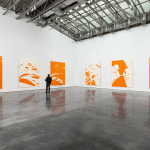Contributed by Jonathan Stevenson / Artists� instrumentalization of their children in their work intuitively seems to breach the parental duty of protection, and to exploit their youth at the risk of maladjustment. Sally Mann�s infamously risqu� deployment of her sometimes naked children in her photographs is well short of pedophilic, often disruptively revelatory and moving, and undoubtedly true art. The pictures are intended to take people aback and thereby make them think. Still, the kids themselves probably couldn�t yet fathom the boundary between art and real life. So the upshot, as Richard B. Woodward observed in a 2015 article in the New York Times Sunday Magazine, is that the pictures unnaturally �seem to accelerate the children�s maturity, rather than to preserve their innocence.� To such a remark Caleb Fang, a notorious patriarchal performance artist played by Christopher Walken with electrifying petulance in The Family Fang, would say, �So what?�
In this inventive black comedy based on Kevin Wilson�s novel, Caleb and his wife Camille � a deceptively meek Maryann Plunkett � dupe the public with shocking scenes, sometimes involving their real or feigned injury, amplifying queasily stunning effects by enlisting their two children Annie (Nicole Kidman, vanity-free, who produced the film) and Baxter (Bateman, in sad-sack mode, who directed) as Child A and Child B. The children remain in palsied thrall to their parents well into adulthood. Despite their troubles, Caleb�s dismissive position is that participating in his art has made their lives unique and fascinating. What else matters?
The senior Fangs disdain innocence. Their performances, bordering on pranks, involve messing with na�ve expectations and order. Annie attributes the rockiness of her acting career, Baxter his writer�s block, to the neurosis that their forced participation in their parents� projects bred into them. When Caleb and Camille disappear, apparent murder victims, Annie and Baxter suspect it�s another performance and investigate. A final act of collusion, paradoxically, sets them free. Yet their flamboyant episodes � her counter-phobic topless stroll through a movie set, his wounding by a potato gun in a beer-soaked William Tell scenario � really are endearing, and do make them interesting. And whatever their troubles, they are relatively high achievers even before their catharsis. From that perspective, the premise that Annie and Baxter were profoundly damaged seems tenuous. The takeaway may be that they are a little less tragic, and their artist parents a little less villainous, than they think.
Related posts
ON FILM: Blonde on blondes
Two Coats urges mothers to apply for art reality show
DISCUSSION: Owning motherhood
——
Two Coats of Paint is licensed under a Creative Commons Attribution – Noncommercial-No Derivative Works 3.0 United States License. To use content beyond the scope of this license, permission is required.























